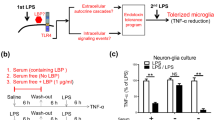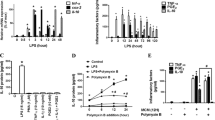Abstract
Endotoxin tolerance (ET) represents a state of an altered immune response induced by multiple stimulations of a cell, a tissue, or an organism with lipopolysaccharide. Characteristics of ET include downregulation of induction of proinflammatory genes (TNFα, IL6, and others) and enhancement of induction of antiinflammatory genes (IL10, TGFβ). ET generally has protective functions; nevertheless, it might result in a state of innate immune deficiency and cause negative outcomes. A current issue is the search for the mechanisms controlling the level of inflammation in the course of endotoxin tolerance. In this work, we investigated the change in cyclooxygenase 2 (Cox2) expression in the model of endotoxin tolerance in astrocytes and analyzed the possibility of regulating this process applying nuclear receptor PPAR agonists. Our results indicate that: 1) endotoxin tolerance can be induced in astrocytes and results in TNFα and Cox2 mRNA induction decrease upon secondary stimulation; 2) tolerance is revealed on the level of TNFα release and Cox2 protein expression; 3) PPAR agonists GW7647, L-165041, and rosiglitazone control Cox2 mRNA expression levels under conditions of endotoxin tolerance. In particular, rosiglitazone (a PPARγ agonist) induces Cox2 mRNA expression, while GW7647 (a PPARα agonist) and L-165041 (a PPARβ agonist) suppress the expression. Our results demonstrate that Cox2 can be upand downregulated during endotoxin tolerance in astrocytes, and PPAR agonists might be effective for controlling this target under conditions of multiple proinflammatory stimulations of brain tissues with endotoxin.
Similar content being viewed by others
Abbreviations
- CNS:
-
central nervous tissue
- Cox2:
-
cyclooxygenase 2
- ET:
-
endotoxin tolerance
- IL6:
-
interleukin 6
- LDH:
-
lactate dehydrogenase
- LPS:
-
lipopolysaccharide (endotoxin)
- PPAR:
-
peroxisome proliferator-activated receptors
- TNFα:
-
tumor necrosis factor alpha
References
Biswas, S. K., and Lopez-Collazo, E. (2009) Endotoxin tolerance: new mechanisms, molecules and clinical signifi-cance, Trends Immunol., 30, 475–487.
West, M. A., and Heagy, W. (2002) Endotoxin tolerance: a review, Crit. Care Med., 30, S64–S73.
Nahid, M. A., Satoh, M., and Chan, E. K. L. (2011) MicroRNA in TLR signaling and endotoxin tolerance, Cell Mol. Immunol., 8, 388–403.
Rosenzweig, H. L., Lessov, N. S., Henshall, D. C., Minami, M., Simon, R. P., and Stenzel-Poore, M. P. (2004) Endotoxin preconditioning prevents cellular inflam-matory response during ischemic neuroprotection in mice, Strok., 35, 2576–2581.
Vartanian, K. B., Stevens, S. L., Marsh, B. J., Williams-Karnesky, R., Lessov, N. S., and Stenzel-Poore, M. P. (2011) LPS preconditioning redirects TLR signaling fol-lowing stroke: TRIF-IRF3 plays a seminal role in mediat-ing tolerance to ischemic injury, J. Neuroinflamm., 8, 160.
Cavaillon, J. M., and Adib-Conquy, M. (2006) Bench-to-bedside review: endotoxin tolerance as a model of leuko-cyte reprogramming in sepsis, Crit. Car., 10, 233.
Farina, C., Aloisi, F., and Meinl, E. (2007) Astrocytes are active players in cerebral innate immunity, Trends Immunol., 28, 138–145.
Gorina, R., Font-Nieves, M., Marquez-Kisinousky, L., Santalucia, T., and Planas, A. M. (2011) Astrocyte TLR4 activation induces a proinflammatory environment through the interplay between MyD88-dependent NF?B signaling, MAPK, and Jak1/Stat1 pathways, Gli., 59, 242–255.
Aleshin, S., Grabeklis, S., Hanck, T., Sergeeva, M., and Reiser, G. (2009) Activated receptor PPAR-? positively controls and PPARa negatively controls cyclooxygenase-2 expression in rat brain astrocytes through a convergence on PPARß/d via mutual control of PPAR expression levels, Mol. Pharmacol., 76, 414–424.
Chistyakov, D. V., Aleshin, S. E., Astakhova, A. A., Sergeeva, M. G., and Reiser, G. (2015) Regulation of per-oxisome proliferator-activated receptors (PPAR) a and ? of rat brain astrocytes in the course of activation by toll-like receptor agonists, J. Neurochem., March 25, DOI: 10.1111/jnc.13101 [E-pub ahead of print].
Chistyakov, D. V., Aleshin, S., Sergeeva, M. G., and Reiser, G. (2014) Regulation of peroxisome proliferator-activated receptor ß/d expression and activity levels by toll-like receptor agonists and MAP kinase inhibitors in rat astro-cytes, J. Neurochem., 130, 563–574.
Donovan, F. M., Pike, C. J., Cotman, C. W., and Cunningham, D. D. (1997) Thrombin induces apoptosis in cultured neurons and astrocytes via a pathway requiring tyro-sine kinase and RhoA activities, J. Neurosci., 17, 5316–5326.
Chen, Y. M., and Swanson, R. A. (2003) Astrocytes and brain injury, J. Cereb. Blood Flow Metab., 23, 137–149.
Beurel, E., and Jope, R. S. (2010) Glycogen synthase kinase-3 regulates inflammatory tolerance in astrocytes, Neuroscienc., 169, 1063–1070.
Beurel, E. (2011) HDAC6 regulates LPS-tolerance in astrocytes, PLoS One, 6, e25804.
Kaufmann, W. E., Andreasson, K. I., Isakson, P. C., and Worley, P. F. (1997) Cyclooxygenases and the and the cen-tral nervous system, Prostaglandin., 54, 601–624.
Varfalomeeva, A. T., and Sergeeva, M. G. (2006) Arachidonic Acid Cascade [in Russian], Narodnoe Obrazovanie, Moscow.
Ricciotti, E., and FitzGerald, G. A. (2011) Prostaglandins and inflammation, Arterioscler. Thromb. Vasc. Biol., 31, 986–1000.
Chan, M. M.-Y., and Moore, A. R. (2010) Resolution of inflammation in murine autoimmune arthritis is disrupted by cyclooxygenase-2 inhibition and restored by prostaglandin E2-mediated lipoxin A(4) production, J. Immunol., 184, 6418–6426.
Rajakariar, R., Yaqoob, M. M., and Gilroy, D. W. (2006) COX-2 in inflammation and resolution, Mol. Interv., 6, 199–207.
Learn, C. A., Mizel, S. B., and McCall, C. E. (2000) mRNA and protein stability regulate the differential expression of pro- and anti-inflammatory genes in endo-toxin-tolerant THP-1 cells, J. Biol. Chem., 275, 12185–12193.
Spitzer, J. A., Zheng, M. Q., Kolls, J. K., Stouwe, C. V., and Spitzer, J. J. (2002) Ethanol and LPS modulate NF-?B activation, inducible NO synthase and COX-2 gene expres-sion in rat liver cells in vivo, Front. Biosci., 7, A99–A108.
Bensinger, S. J., and Tontonoz, P. (2008) Integration of metabolism and inflammation by lipid-activated nuclear receptors, Natur., 454, 470–477.
Heneka, M. T., and Landreth, G. E. (2007) Peroxisome proliferator-activated receptors (PPARs) in skin health, repair and disease, PPARs in the brain, Biochim. Biophys. Act., 1771, 1031–1045.
Michalik, L., and Wahli, W. (2007) Peroxisome prolifera-tor-activated receptors (PPARs) in skin health, repair and disease, Biochim. Biophys. Act., 1771, 991–998.
Rainsford, K. D. (2007) Anti-inflammatory drugs in the 21st century, Subcell. Biochem., 42, 3–27.
Sergeeva, M. G., Aleshin, S. E., Grabeklis, S., and Reiser, G. (2010) PPAR activation has dichotomous control on the expression levels of cytosolic and secretory phospholipase A2 in astrocytes; inhibition in naive, untreated cells and enhancement in LPS-stimulated cells, J. Neurochem., 115, 399–410.
Aleshin, S., Strokin, M., Sergeeva, M., and Reiser, G. (2013) Peroxisome proliferator-activated receptor (PPAR) ß/d, a possible nexus of PPARa- and PPAR?-dependent molecular pathways in neurodegenerative diseases: review and novel hypotheses, Neurochem. Int., 63, 322–330.
Fitch, M. T., and Silver, J. (2008) CNS injury, glial scars, and inflammation: inhibitory extracellular matrices and regeneration failure, Exp. Neurol., 209, 294–301.
Siniscalchi, A., Gallelli, L., Malferrari, G., Pirritano, D., Serra, R., Santangelo, E., and De, S. G. (2014) Cerebral stroke injury: the role of cytokines and brain inflammation, J. Basic Clin. Physiol. Pharmacol., 25, 131–137.
Dirnagl, U., Becker, K., and Meisel, A. (2009) Preconditioning and tolerance against cerebral ischemia: from experimental strategies to clinical use, Lancet Neurol., 8, 398–412.
Hafenrichter, D. G., Roland, C. R., Mangino, M. J., and Flye, M. W. (1994) The Kupffer cell in endotoxin toler-ance: mechanisms of protection against lethal endotox-emia, Shoc., 2, 251–256.
Pena, O. M., Pistolic, J., Raj, D., Fjell, C. D., and Hancock, R. E. (2011) Endotoxin tolerance represents a distinctive state of alternative polarization (M2) in human mononuclear cells, J. Immunol., 186, 7243–7254.
Lopez-Collazo, E., and del Fresno, C. (2013) Pathophysiology of endotoxin tolerance: mechanisms and clinical consequences, Crit. Car., 17, 242.
Karahashi, H., and Amano, F. (2003) Endotoxin-tolerance to the cytotoxicity toward a macrophage-like cell line, J774.1, induced by lipopolysaccharide and cycloheximide: role of p38 MAPK in induction of the cytotoxicity, Biol. Pharm. Bull., 26, 1249–1259.
Erta, M., Quintana, A., and Hidalgo, J. (2012) Interleukin-6, a major cytokine in the central nervous system, Int. J. Biol. Sci., 8, 1254–1266.
Lawrence, T., Gilroy, D. W., Colville-Nash, P. R., and Willoughby, D. A. (2001) Possible new role for NF-?B in the resolution of inflammation, Nat. Med., 7, 1291–1297.
Nadeau, S., Filali, M., Zhang, J., Kerr, B. J., Rivest, S., Soulet, D., Iwakura, Y., de Rivero Vaccari, J. P., Keane, R. W., and Lacroix, S. (2011) Functional recovery after peripheral nerve injury is dependent on the pro-inflamma-tory cytokines IL-1ß and TNF: implications for neuropath-ic pain, J. Neurosci., 31, 12533–12542.
Aid, S., Langenbach, R., and Bosetti, F. (2008) Neuroinflammatory response to lipopolysaccharide is exacerbated in mice genetically deficient in cyclooxyge-nase-2, J. Neuroinflamm., 5, 17.
Blais, V., Turrin, N. P., and Rivest, S. (2005) Cyclooxygenase 2 (COX-2) inhibition increases the inflam-matory response in the brain during systemic immune stim-uli, J. Neurochem., 95, 1563–1574.
Gupta, A., Kumar, A., and Kulkarni, S. K. (2011) Targeting oxidative stress, mitochondrial dysfunction and neuroinflammatory signaling by selective cyclooxygenase (COX)-2 inhibitors mitigates MPTP-induced neurotoxici-ty in mice, Prog. Neuropsychopharmacol. Biol. Psychiatr., 35, 974–981.
Phillis, J. W., Horrocks, L. A., and Farooqui, A. A. (2006) Cyclooxygenases, lipoxygenases, and epoxygenases in CNS: their role and involvement in neurological disorders, Brain Res. Rev., 52, 201–243.
Trepanier, C. H., and Milgram, N. W. (2010) Neuroinflammation in Alzheimer’s disease: are NSAIDs and selective COX-2 inhibitors the next line of therapy? J. Alzheimer’s Dis., 21, 1089–1099.
Luna-Medina, R., Cortes-Canteli, M., Alonso, M., Santos, A., Martinez, A., and Perez-Castillo, A. (2005) Regulation of inflammatory response in neural cells in vitro by thiadiazolidinones derivatives through peroxisome pro-liferator-activated receptor gamma activation, J. Biol. Chem., 280, 21453–21462.
Pahan, K., Jana, M., Liu, X., Taylor, B. S., Wood, C., and Fischer, S. M. (2002) Gemfibrozil, a lipid-lowering drug, inhibits the induction of nitric oxide synthase in human astrocytes, J. Biol. Chem., 277, 45984–45991.
Xu, J., Chavis, J. A., Racke, M. K., and Drew, P. D. (2006) Peroxisome proliferator-activated receptor-alpha and retinoid X receptor agonists inhibit inflammatory responses of astrocytes, J. Neuroimmunol., 176, 95–105.
Michalik, L., Auwerx, J., Berger, J. P., Chatterjee, V. K., Glass, C. K., Gonzalez, F. J., Grimaldi, P. A., Kadowaki, T., Lazar, M. A., O’Rahilly, S., Palmer, C. N., Plutzky, J., Reddy, J. K., Spiegelman, B. M., Staels, B., and Wahli, W. (2006) International Union of Pharmacology. LXI. Peroxisome pro-liferator-activated receptors, Pharmacol. Rev., 58, 726–741.
Cristiano, L., Cimini, A., Moreno, S., Ragnelli, A. M., and Paola, C. M. (2005) Peroxisome proliferator-activated receptors (PPARs) and related transcription factors in dif-ferentiating astrocyte cultures, Neuroscienc., 131, 577–587.
Paterniti, I., Impellizzeri, D., Crupi, R., Morabito, R., Campolo, M., Esposito, E., and Cuzzocrea, S. (2013) Molecular evidence for the involvement of PPAR-delta and PPAR-gamma in anti-inflammatory and neuroprotective activities of palmitoylethanolamide after spinal cord trau-ma, J. Neuroinflamm., 10, 20.
Author information
Authors and Affiliations
Corresponding author
Additional information
Published in Russian in Biokhimiya, 2015, Vol. 80, No. 10, pp. 1532-1541.
Originally published in Biochemistry (Moscow) On-Line Papers in Press, as Manuscript BM15-110, August 2, 2015.
Rights and permissions
About this article
Cite this article
Astakhova, A.A., Chistyakov, D.V., Pankevich, E.V. et al. Regulation of cyclooxygenase 2 expression by agonists of PPAR nuclear receptors in the model of endotoxin tolerance in astrocytes. Biochemistry Moscow 80, 1262–1270 (2015). https://doi.org/10.1134/S0006297915100065
Received:
Revised:
Published:
Issue Date:
DOI: https://doi.org/10.1134/S0006297915100065




